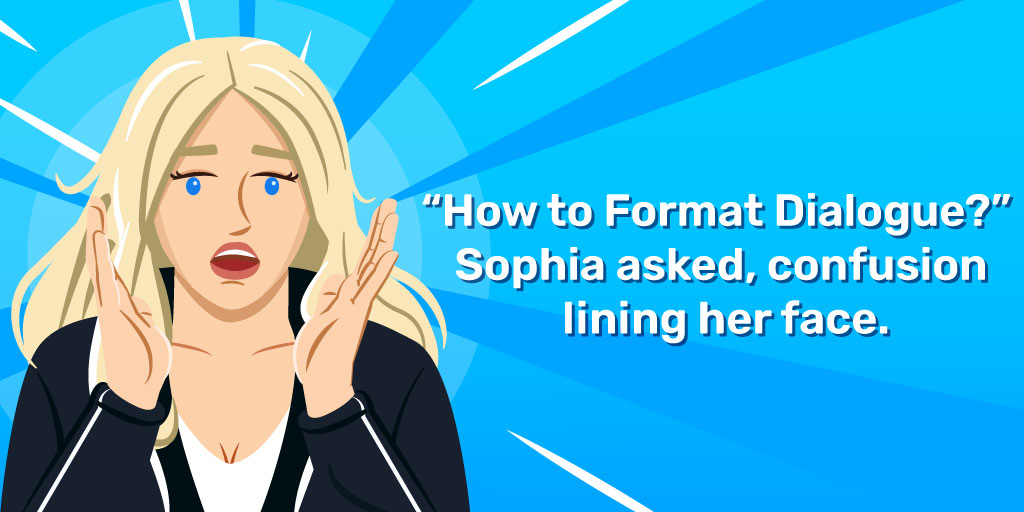Effective dialogue is a crucial element in any work of fiction; it breathes life into characters, conveys emotions, and propels the plot forward. However, crafting compelling dialogue is not just about the words spoken; it’s also about how they are presented on the page. Proper formatting of dialogue plays a pivotal role in ensuring clarity, readability, and seamless communication between the characters and the readers.
This is a comprehensive guide that will offer you a clear understanding of the rules and provide practical examples that will help you master the art of formatting dialogue in your novel or short story. By the end of this guide, you will possess a solid foundation in dialogue formatting, empowering you to confidently create authentic, engaging conversations between your characters.
How to Format Dialogue in a Story
Clear formatting is of paramount importance when it comes to dialogue in your novel or short story. Proper formatting ensures that readers can easily distinguish between dialogue and narration, allowing them to follow conversations effortlessly. It provides visual cues that help readers identify who is speaking and when thereby preventing confusion or ambiguity.
Well-formatted dialogue allows readers to immerse themselves in the characters’ interactions, understand their emotions, and grasp the subtleties of their conversations.
In addition, this reflects your professionalism as a writer, highlighting your keen attention to detail and unwavering commitment to a polished manuscript. Through careful attention to clear and accurate dialogue formatting, you facilitate an effective exchange between your characters and readers, creating an immersive and captivating reading experience.
Below, you will find a comprehensive list of the formatting rules and conventions to follow for clearly formatted dialogue.
Craft of Writing Quiz (Easy)

1. Enclose Dialogue in Quotation Marks
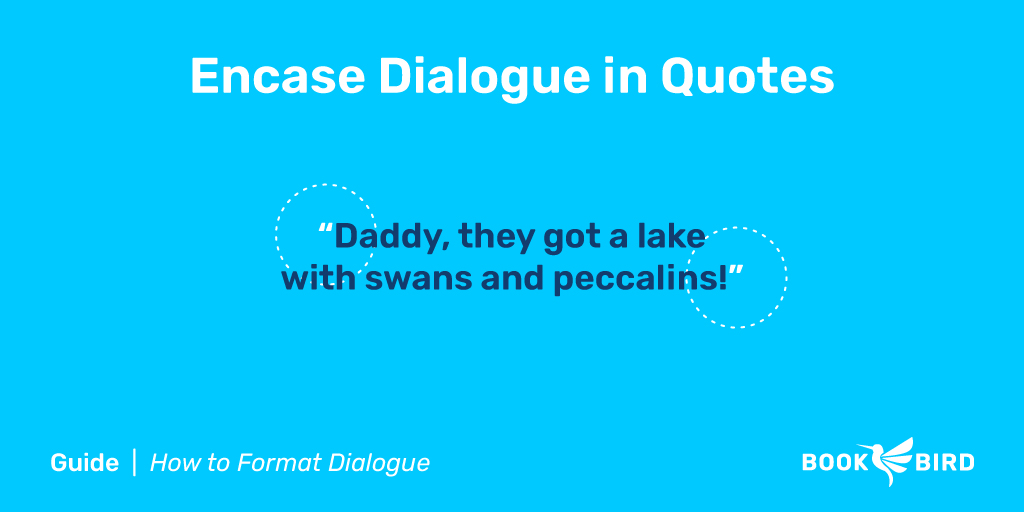
Words spoken by a character must be enclosed within double quotation marks to clearly indicate that it is uttered and to distinguish it from surrounding narration.
This is an example from “Patriot Games” by Tom Clancy:
She pointed to the park. “Daddy, they got a lake with swans and peccalins!”
“Pelicans,” Jack corrected.
In British English, single quotes are used to enclose dialogue, as in this example from the British author Rosamunde Pilcher from her book “Coming Home”:
For a bit, neither of them spoke. Then Judith sighed.
‘Well,’ she said in final tones, ‘that’s it.’
‘Must feel a bit funny, knowing you’re not coming back again.’
‘Yes, it does. But the funniest bit is feeling sad. I never thought I’d feel sad to leave any school, but I do now.’
If you self-publish your books, make sure that you stick diligently to one of the two conventions to ensure consistency.
2. Use Speaker Tags to Identify the Speaker

Speaker tags, such as “he said” or “she asked,” are used to attribute dialogue to the character who spoke it, providing clarity and context.
Here is an example of three people speaking and being clearly distinguished from each other with speaker tags. It’s taken from “The Silence of the Lambs” by Thomas Harris:
“Do you think he’s holding another woman right this minute while we’re looking at his bug?” Roden asked in her face.
“I don’t know.” A little shrill, that. “I don’t know,” she said again to take the edge off it. “He’ll do it again as soon as he can.”
“So we’ll do this as soon as we can,” Pilcher said.
3. Use Commas to Separate Speaker Tags from Dialogue
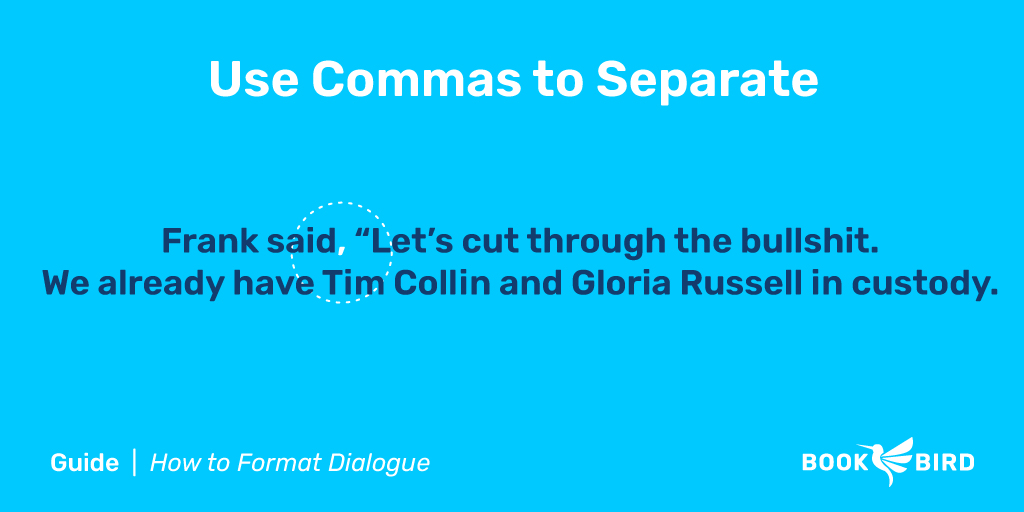
When you include a speaker tag to indicate who is speaking, a comma should separate the tag from the spoken words. This can be done in two ways, each with its own rule for comma placement.
If the speaker tag precedes the dialogue, you should end the tag with a comma, after which you open the quote to insert the dialogue.
Look at this example from David Baldacci’s “Absolute Power”, when Detective Frank told the American president that his career and freedom were over:
Frank said, “Let’s cut through the bullshit. We already have Tim Collin and Gloria Russell in custody.
They’ve both waived right to counsel, and each has given detailed depositions regarding all of the events involving the homicides of Christine Sullivan, Luther Whitney, Walter Sullivan and the two killings at Patton, Shaw.
I believe they’ve already cut deals with the prosecutors, who are really only interested in you anyway.”
If the speaker tag follows the dialogue, the comma should be placed before the closing quotation marks.
In “Twenties Girl” by Sophie Kinsella, the ghost of Lara’s great-aunt comes up with this:
“I don’t believe in ghosts,” she says disparagingly.
4. Place Punctuation Inside Quotation Marks

Punctuation marks such as commas, periods, and question marks are placed inside the closing quotation marks to indicate they are part of the spoken sentence.
Mary Higgins Clark wrote this paragraph in her novel, “No Place Like Home”:
She could still feel her forehead slamming into the sand when the wave crashed them onto the shore.
She had swallowed water and was coughing, and her eyes were stinging, and she was crying, but then Daddy pulled her onto his lap.
“Now that was a wave!” he said, as he brushed the sand from her face, “but we rode it out together, didn’t we, Liza?”
5. Start a New Paragraph for Each Change in Speaker
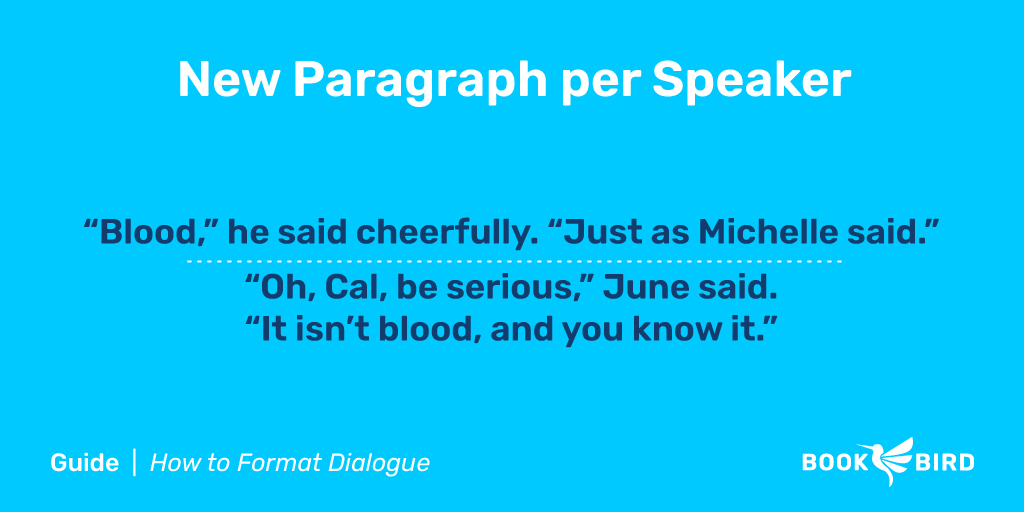
A new paragraph is used for each change in speaker to visually separate the contributions of different speakers to the dialogue. This greatly improves readability.
Here is a conversation between a husband and wife in John Saul’s “Comes the Blind Fury”:
Suddenly her eyes fell to the strange stain on the floor, and she frowned. “What do you suppose it is?” she asked Cal as his gaze followed her own.
“Blood,” he said cheerfully. “Just as Michelle said.”
“Oh, Cal, be serious,” June said. “It isn’t blood, and you know it.”
“Then what are you worried about?”
“I’d just like to know what it is, so I’ll know what to use to get it off,” June said.
6. Use a Separate Sentence for Actions Outside the Dialogue

When describing actions or thoughts that take place just before or after a character’s spoken words, it is important to give those actions their own sentence.
“Flowers in the Attic” by V.C. Andrews contains this discussion:
Chris turned aside his head. “Okay. We’ve got to make a test. We’re going to feed Cory’s pet mouse a bit of powdered-sugar doughnut.”
No! Not Mickey, who trusted and loved us—we couldn’t do that. Cory had adored the little gray mouse. “Chris, let’s catch another mouse—a wild one that doesn’t trust us.”
7. Capitalize Correctly After Speaker Tags
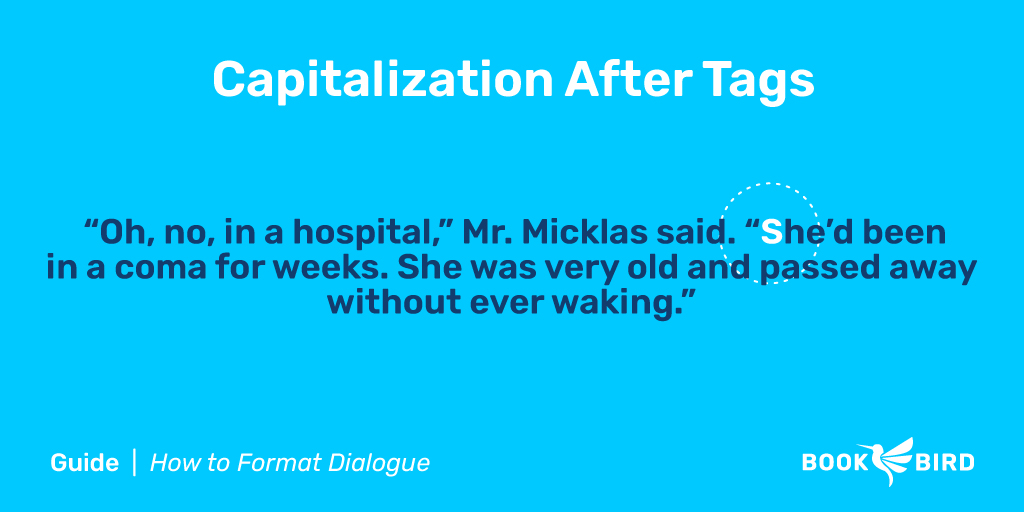
When a speaker tag appears between two of a speaker’s sentences, the first word after the quote starts with a capital letter, as it does with any new sentence. When the speaker tag appears in the middle of a spoken sentence, however, the first word after the quote is not capitalized because it is a continuation of a sentence.
These two statements from “Rosemary’s Baby” by Ira Levin demonstrate the difference nicely:
“Oh, no, in a hospital,” Mr. Micklas said. “She’d been in a coma for weeks. She was very old and passed away without ever waking.”
“The previous tenant, Mrs. Gardenia,” Mr. Micklas said, not looking back at them, “passed away only a few days ago, and nothing has been moved out of the apartment yet.”
8. Use Single Quotes for Quoted Text
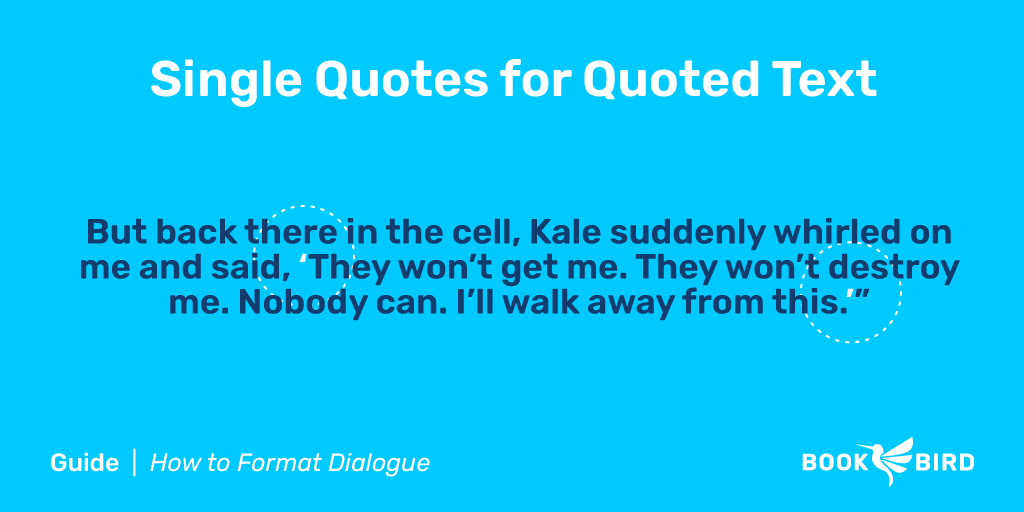
When a character quotes someone else within their dialogue, use single quotation marks to differentiate the quoted text from the character’s own words.
In Dean Koontz’s “Phantoms”, a lawyer describes his client as evil:
“I thought I was too well educated to believe that Evil—with a capital E—stalks the world on cloven hooves. But back there in the cell, Kale suddenly whirled on me and said, ‘They won’t get me. They won’t destroy me. Nobody can. I’ll walk away from this.’”
9. Indicate Interruptions with Em Dashes
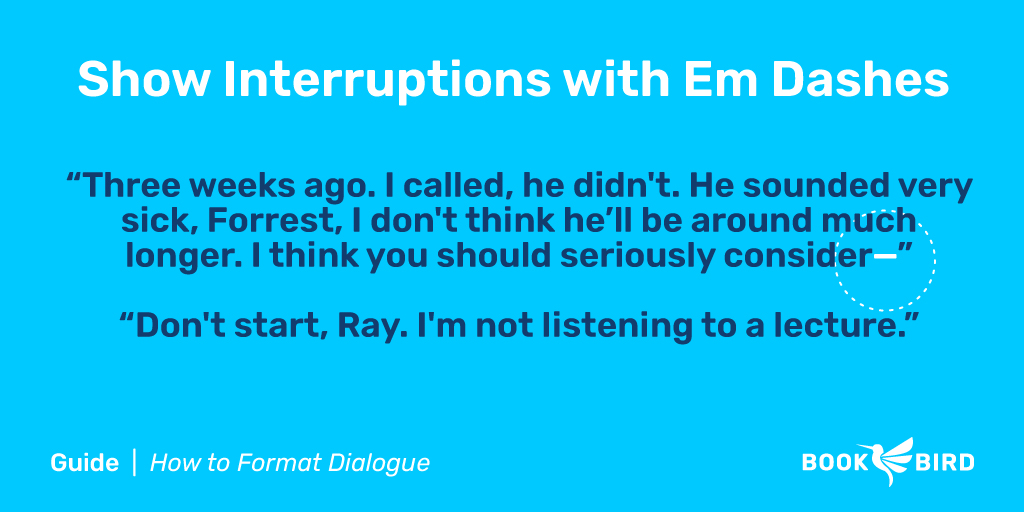
Em dashes are used to indicate interruptions in dialogue, such as when one speaker breaks in on another.
Here is a rather rude interruption from “The Summons” by John Grisham:
“Have you talked to him?”
“Three weeks ago. I called, he didn’t. He sounded very sick, Forrest, I don’t think he’ll be around much longer. I think you should seriously consider—”
“Don’t start, Ray. I’m not listening to a lecture.”
10. Mark the Trailing Off of Speech with Ellipses

When a character’s speech trails off—for instance, when they’re unsure how to complete a sentence—use ellipses, followed by a quotation mark, without any additional punctuation like a comma or period.
Kristin Hannah’s Alaskan novel “The great alone” contains the following example:
Leni sat down beside him. He put an arm around her, pulled her in close. “The world is being run by lunatics. It’s not my America anymore. I want…” He didn’t finish, and Leni didn’t say anything.
11. Close the Quote Only Once in Multiple-Paragraph Speeches
If a character’s spoken words span multiple paragraphs, without any interruptions, use opening quotation marks at the beginning of each paragraph, but omit closing quotation marks until the end of the final paragraph.
In “Pet Sematary” by Stephen King, Jud tells Louis a long story about how Stanny B. introduced him to the burial place:
“We went up there, the two of us, and I guess Stanny B. must have fallen down half a dozen times if he fell down once. He was really far gone; smelled like he’d fallen into a vat of corn. One time he damn near put a stick through his throat. But he had a pick and shovel with him. When we got to the Pet Sematary, I kind of expected he’d sling me the pick and shovel and just pass out while I dug the hole.
“Instead, he seemed to sober up a little. He told me we was goin on, up over the deadfall and deeper into the woods, where there was another burial place. I looked at Stanny, who was so drunk he could barely keep his feet, and I looked at that deadfall, and I said, ‘You can’t climb that, Stanny B., you’ll break your neck.’
“And he said, ‘I ain’t gonna break my neck, me, and neither are you. I can walk, and you can lug your dog.’ And he was right. He sailed up over that deadfall just as smooth as silk, never even looking down, and I lugged Spot all the way up there, although he must have weighed thirty-five pounds or so and I only went about ninety myself. I want to tell you, though, Louis, I was some sore and sprung the next day. How do you feel today?”
12. Avoid Excessive Dialogue Tags
Use dialogue tags sparingly and only when necessary to indicate who is speaking. Overusing dialogue tags can become repetitive and disrupt the flow of the conversation.
Look at this conversation between Emily and Jess in Michael Palmer’s medical thriller “The Patient”:
She was just finishing when Emily came in.
“Sara’s wide awake,” she said excitedly.
“Talking?”
“She’s not ready for the debating society, but she’s certainly making her needs understood. You’re on a helluva roll today, Jess.”
“Carl’s still there with her?”
“A man on a mission.”
“Maybe someone should have smashed him across the face with a gun a long time ago.”
“Amen to that,” Emily said.
13. Break Dialogue with Actions or Descriptions
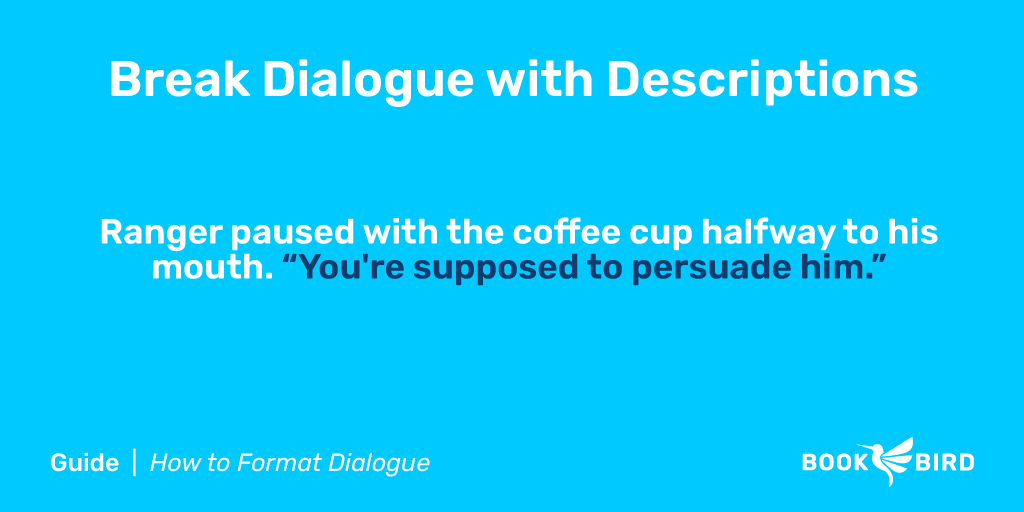
Instead of relying solely on dialogue tags, incorporate descriptive beats or actions that provide context or convey the speakers’ emotions. These beats can enhance the scene and provide visual cues to readers.
Take this scene from “Ten Big Ones” by Janet Evanovich:
“Connie and Lula and I kidnapped a Slayer. The plan was to get him to talk to us about Junkman, but we haven’t had any luck.”
Ranger finished his bagel and pushed back from the table to finish his coffee. “Kidnapping a Slayer is good. Why wouldn’t he talk?”
“He didn’t want to.”
Ranger paused with the coffee cup halfway to his mouth. “You’re supposed to persuade him.”
“We were going to slap him around, but when we got him tied to the chair, it turned out none of us could hit him.”
Ranger burst out laughing, and coffee sloshed out of his cup onto the table. He put the coffee down and reached for his napkin, trying not to laugh, not having a lot of luck at it.
“Jeez,” I said. “I think that’s the first time I’ve ever seen you laugh like that.”
14. Choose Simple Speaker Tags
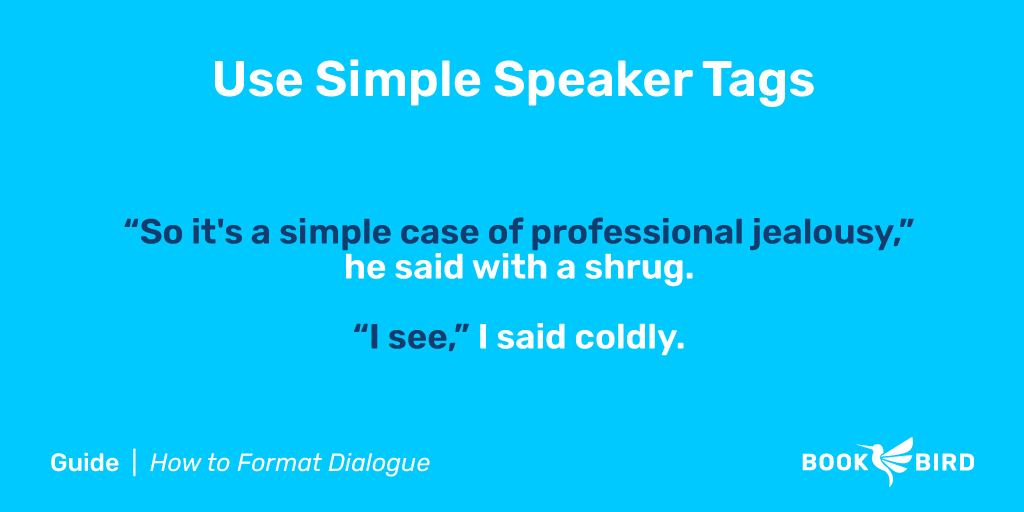
Many writers don’t want to keep on using said and asked because they are boring and might get monotonous. This is certainly true if they are overused. But alternative tags like recited, advised, asserted, and the like sound too formal. Other potential tags like bellowed and growled simply sound too funny when they are used often.
The trick is to use said, but to use it along with a little qualifier or description.
Here are lots of examples from Patricia Cornwell’s novel “Postmortem”:
“Berkley’s in Berkley Downs, Southside,” he said condescendingly.
“Literature,” he said again, slowly enunciating each syllable.
“Ain’t this the pits?” Marino said with disgust as he patted himself down for his cigarettes.
As I turned the ignition, he leaned down and said with a smirk, “Drive real careful, Doc.”
“They’re partials,” he said abstractedly as he began taking photographs
“Try the ligature around her ankles,” I said quietly.
15. Use Italics for Inner Thoughts

Italics are used to convey a character’s inner thoughts or mental dialogue, setting them apart from spoken words and normal narration.
In Joy Fielding’s novel “Puppet”, lawyer Amanda has flashbacks to a phone call that she received the previous day while she was doing her shopping:
Amanda becomes aware of a phone ringing somewhere beside her. “Oh. Oh, yes.” She reaches inside her black leather purse. “Hello?” she asks timidly.
Finally wore you down, did I?
“What?”
“They just called from court,” her secretary informs her. “The jury’s back.”
16. Separate Direct Address with a Comma

When the speaker directly addresses someone in dialogue, use a comma to separate the direct address from the rest of the sentence.
Consider this sentence from Lawrence Block’s “A Dance at the Slaughterhouse”:
“Matthew, it’s about time you came to see me. I thought you were going to join us last night, you and your friend.”
17. Don’t Use Quotes for Reported Speech
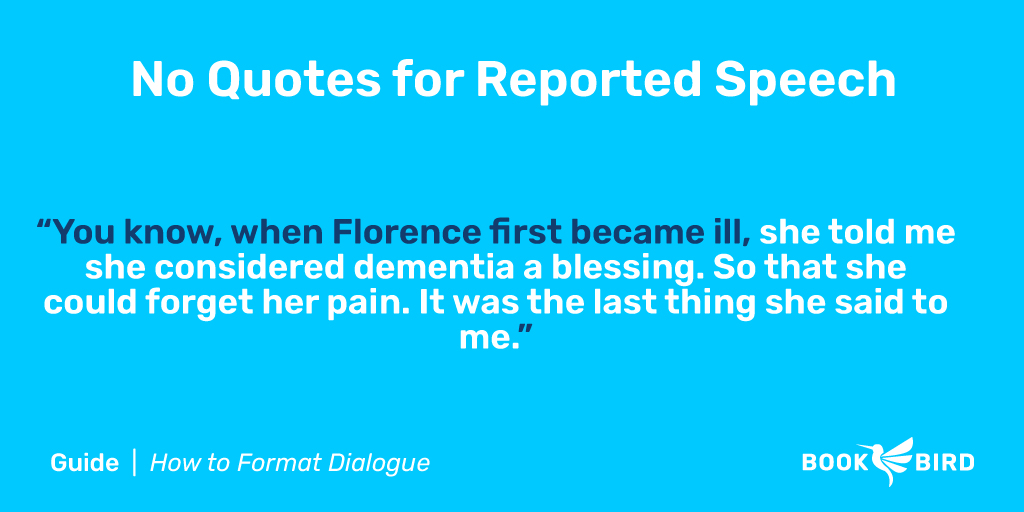
When a speaker doesn’t quote another person directly, but simply reports their speech, no double or single quotes are used around the reported portion.
Here is an example from “The Vessel” by Adam Nevill:
The woman nods in agreement. “You know, when Florence first became ill, she told me she considered dementia a blessing. So that she could forget her pain. It was the last thing she said to me.”
Another possible way to write this paragraph would be the following:
The woman nods in agreement. “You know, when Florence first became ill, she told me, ‘I consider dementia a blessing.’ I asked her, ‘why?’ She responded, ‘So that I can forget my pain.’”
It is best to limit this direct quoting of dialogue to the minimum since it is long and difficult to read. The first formulation that reports the dialogue is substantially better.
18. Reflect Accents or Dialects with Care
When representing accents or dialects in dialogue, use a subtle and judicious approach. Carefully choose specific words, phrasing, or slight modifications to reflect the character’s speech pattern without sacrificing readability.
Unless you are Mark Twain writing a huge classic like “Adventures of Huckleberry Finn”, you probably can’t get away with something like this:
“Well, den, dis is de way it look to me, Huck. Ef it wuz HIM dat ‘uz bein’ sot free, en one er de boys wuz to git shot, would he say, ‘Go on en save me, nemmine ’bout a doctor f’r to save dis one?’ Is dat like Mars Tom Sawyer?”
It’s simply too tiring and slow to read.
But the whole of Stephen King’s “Dolores Claiborne” is written in the following dialect, and it is perfectly readable:
“Well, I went to see the man in charge of the savins department at Coastal Northern in Jonesport,” I says. “A nice man named Mr Pease. I explained what happened, and he was awfully upset. Especially when I showed him the original savins books weren’t missin, like you told him they were.”
Final Thoughts
Mastering the art of dialogue formatting is key for any writer striving to craft captivating, immersive stories. By adhering to the guidelines and examples outlined in this guide, you can create dialogue that’s not only clear and visually appealing, but also powerfully communicates your characters’ voices. Properly formatted dialogue not only heightens reader understanding, but also enriches your storytelling and upholds a professional standard. Thus, commit to these principles, maintain consistency, and allow your characters’ exchanges to glow with true authenticity and impact.
Craft of Writing Quiz (Hard)

